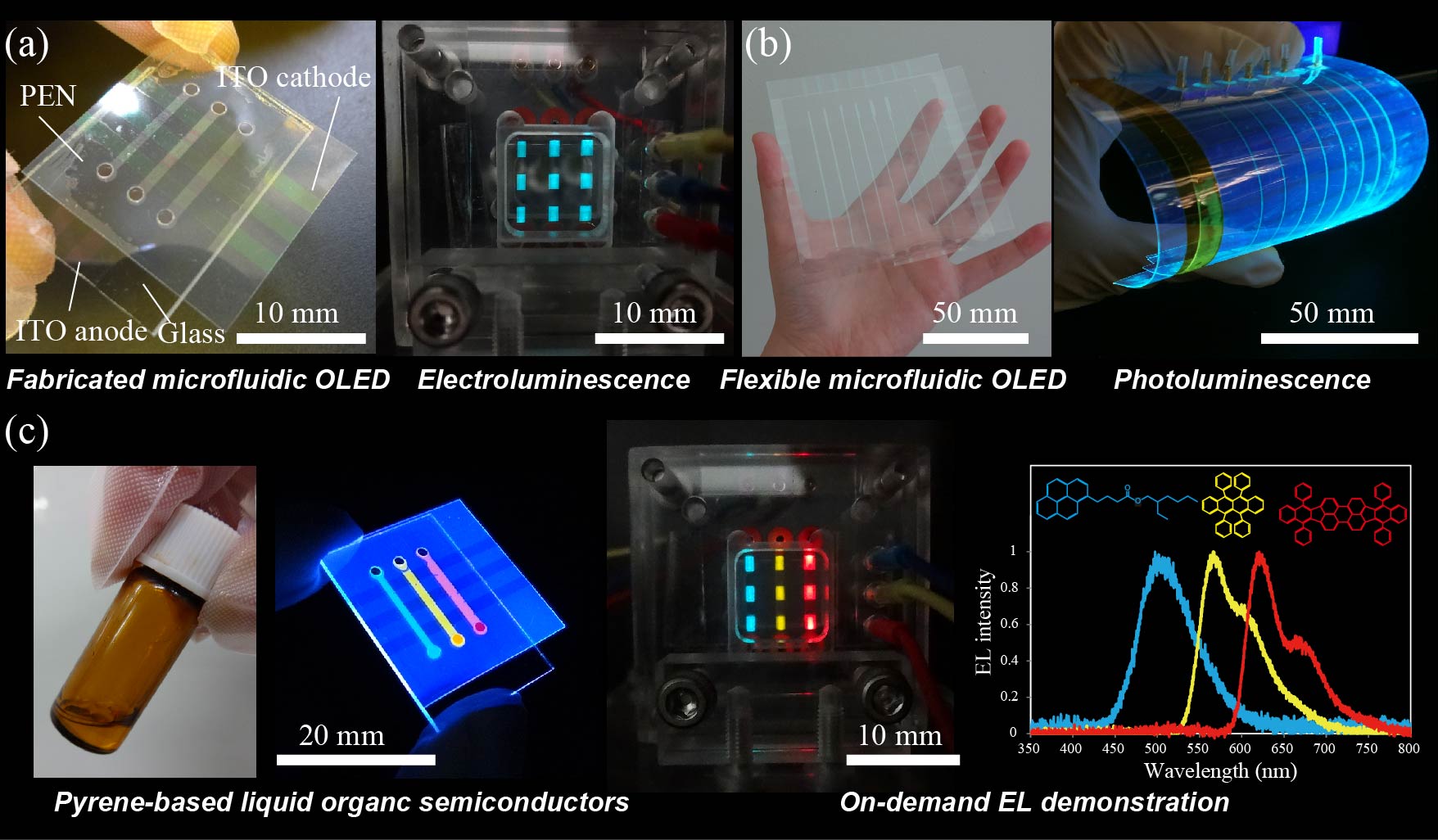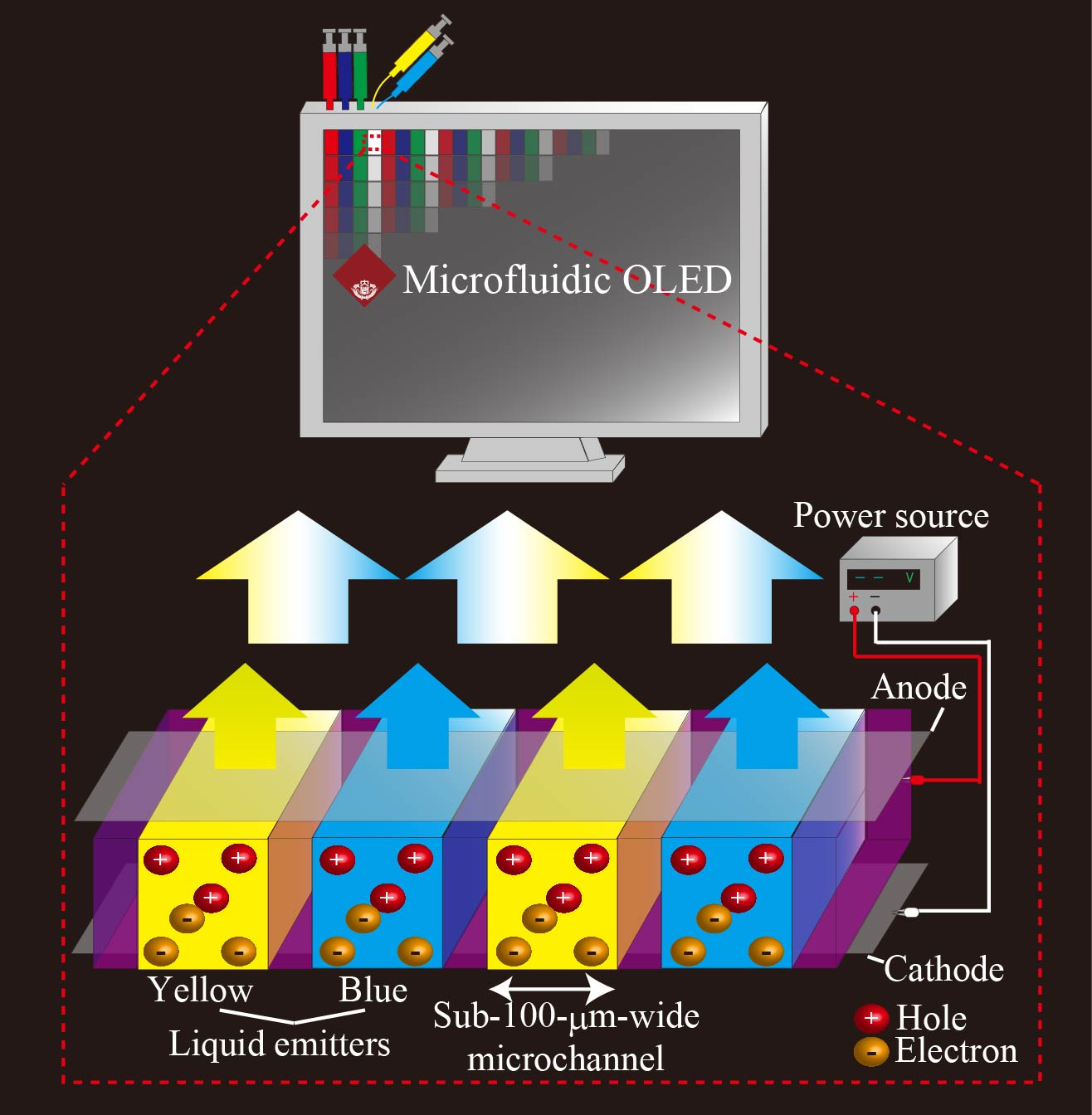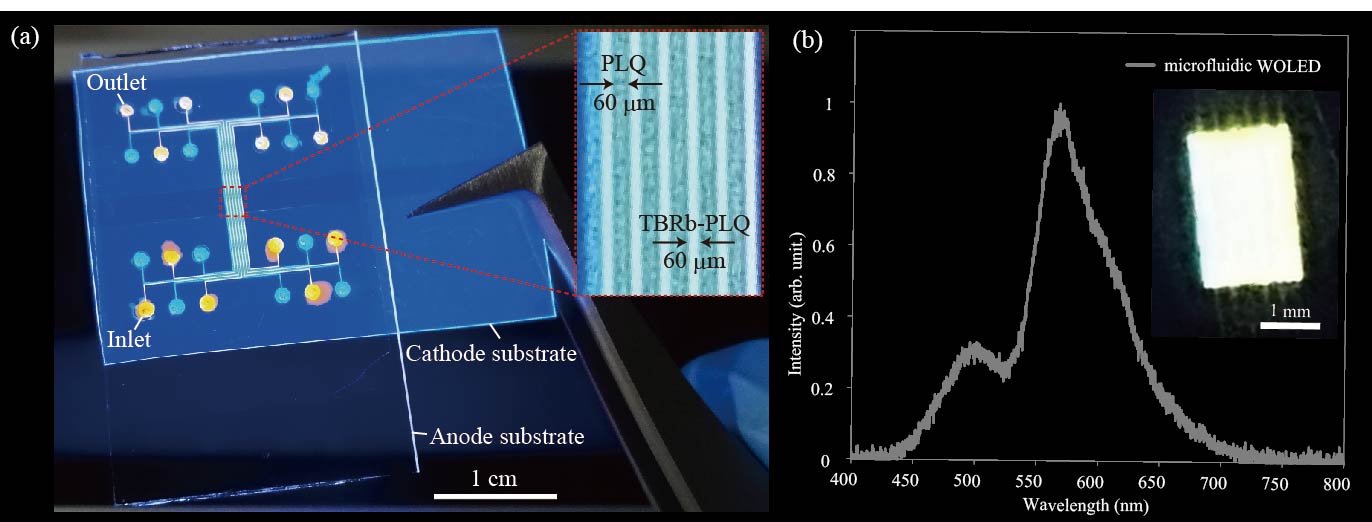A research team comprised of Faculty of Science and Engineering student Naofumi Kobayashi, assistant Takashi Kasahara, Professor Shuichi Shoji, and Professor Jun Mizuno (Research Organization for Nano & Life Innovation) has developed a microfluidic white organic light-emitting diode (microfluidic WOLED), which is a novel liquid OLED realized with highly-integrated electro-microchannels. Instead of solid-state organic semiconductor layers, liquid organic semiconductors were used as greenish-blue and yellow solvent-free liquid emitters. White electroluminescence (EL) emission was successfully obtained via simultaneous greenish-blue and yellow emissions at the light-emitting pixel of the microchannels. The proposed device has potential applications with liquid-based microdisplay subpixels and lighting.
In 2013, the same research group was the first in the world to propose a microfluidic OLED that combined liquid-OLEDs with microfluidic technologies to create a new type of liquid-based display (Sensors and Actuators A, 195 (2013) 219.), as shown in Fig. 1(a). An electro-microfluidic device, which consisted of single μm thick and 1000 to 1500 μm wide negative photoresist SU-8 microchannels was fabricated on a glass substrate using a microelectromechanical systems (MEMS) process and a heterogeneous bonding technique that utilizes self-assembled monolayers (SAMs). The emitting layers were simply formed by injecting the selected liquid emitters into the micorchannels without a vacuum process, and the microfluidic OLED successfully exhibited greenish-blue EL emissions from the light-emitting pixels of the microchannels. Furthermore, that research group developed a new methodology for fabricating flexible microfluidic OLEDs making good use of liquid materials that easily change shape, which is expected to provide flexible and crack-free emitting layers (Sens. Actuators A, 216 (2014) 231.) (Fig. 1(b)). Recently, it is becoming clear that the microfluidic OLEDs have several unique properties such as on-demand multi-color emitting layer formation and luminance refreshable feature, which are difficult to be realized with the conventional solid-state OLEDs (Sensors and Actuators B, 207 (2015) 481.) (Fig. 1(c)). On-demand EL emission characteristics of the microfluidic OLEDs could contribute not only to future unique liquid-based display and lighting, but also to excitation light sources that can be used with portable biochips in the fields of biochemistry and medicine.

Fig. 1 Microfluidic OLED technology
In this study, Mizuno and his group demonstrated the microfluidic WOLED according to both the fabrication methodology for the electro-microfluidic device (Sensors and Actuators A, 195 (2013) 219.) and the color tuning method of pyrene-based liquid organic semiconductors (Sensors and Actuators B, 207 (2015) 481.). The concept of the microfluidic WOLED is shown in Fig. 2. Integrated 6-μm-thick and sub-100-μm-wide microchannels sandwiched between two transparent electrodes were fabricated by MEMS process and heterogeneous bonding technique through the use of amine- and epoxy- terminated SAMs. A pyrene-based liquid organic semiconductor (PLQ) (Nissan Chemical Industries, Ltd.) was used as the greenish-blue liquid emitter, while the TBRb-doped PLQ was prepared as the yellow liquid emitters. A white light-emitting layer was simply obtained by alternately injecting the greenish-blue and yellow liquid emitters into the integrated microchannels (Fig. 3(a)). The fabricated microfluidic WOLED successfully exhibited white EL emission, which covers the broad spectrum ranging from 420 nm to 750 nm, via simultaneous greenish-blue and yellow emissions under an applied voltage of 100 V (Fig. 3(b)). A warm-white emission with Commission Internationale de l’Ѐclairage (CIE) color coordinates of (0.40, 0.42) was also obtained. The authors expect that the proposed microfluidic WOLED will be highly promising technologies for future liquid-based RGBW microdisplays and for lighting.

Fig. 2 Concept of microfluidic WOLED

Fig. 3 Characteristics of microfluidic WOLED
This research received two grants for scientific research from the Ministry of Education, Culture, Sports, Science and Technology (MEXT) and support from the Nanotechnology Platform Support Project.
This research was published in the Nature Publishing Group’s online journal, Scientific Reports.
Microfluidic White Organic Light-Emitting Diode Based on Integrated Patterns of Greenish-Blue and Yellow Solvent-Free Liquid Emitters








